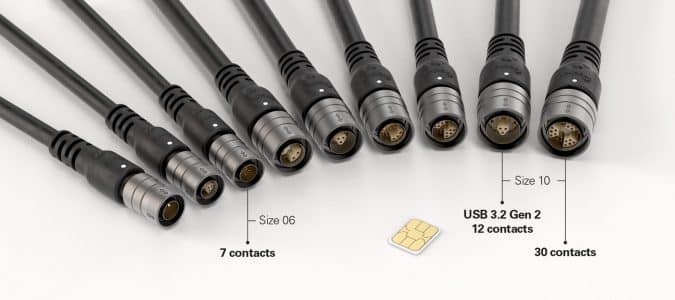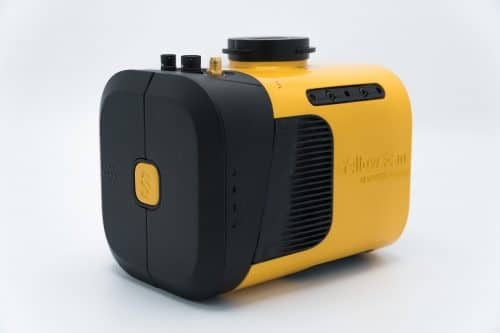The flagship product line Fischer MiniMax Series, which already includes one of the smallest and densest connectors in the world, now includes three connectors and their associated cables with new options in pin layout, body size and data speed:
- New pin-layout configuration: 7 contacts (4x signal, 3x power) in Ø 10 mm receptacle (Fischer Connectors reference ‘size 06’) with a configuration offering up to 22 AWG and a choice of three locking mechanisms (quick-release, push-pull, screw), as a perfect alternative for designing even smaller equipment for the Nett Warrior connectivity ecosystem and for other rugged applications
- New body size: Ø 14.0 mm (size 10) with 12 signal and power contacts offering USB 3.2 Gen 2 (10 Gbit/s, 1 m) and high power up to 8A, suited for high-speed intercom boxes and next-generation hubs
- New ultra-high density: 30 contacts (24x signal, 6x power) in Ø 14.0 mm (size 10), supporting multi-protocol data transmission (such as HDMI, USB, Ethernet) and extending the popular high-density layout offering for instrumentation applications, unmanned systems, and sensor and IoT interconnections.

Increased density and optimised packaging factors for design flexibility
The increased density and optimised packaging factor offered by the MiniMax series apply to a varied array of lightweight and compact solutions, from various connector configurations, through cable assemblies with straight, right-angle or 60° overmolding, to electronic solutions including hubs, flash drives and flex PCB circuits tailored to the size, weight and power (SWaP) requirements of entire electronic systems and ecosystems.
This provides OEM engineers with more flexibility in terms of design when it comes to choosing from different connectivity solutions in line with specific system-level and field-application engineering requirements, harsh operating environments, as well as cost-efficiency criteria.
Smaller connectivity yields big advantages in terms of design integration. For example, the 12 mm diameter receptacle (size 08) with up to 24 power and signal contacts represents up to a 45% space saving compared to standard receptacles with a similar number of contacts. The external dimensions of electronic devices are affected by the growing demand for sensors and mobile (or wearable) electronics as well as for autonomous robotics and vehicles. This implies ever-lighter components. With up to 75% weight saving, the Fischer MiniMax Series achieves both size and weight reduction, maximising performances while minimising the integration burden.
One of the smallest and densest connectors in the world is a Fischer MiniMax connector. The connector in size 06 includes up to 12 power and signal contacts in a footprint of just 10 mm. This represents a density factor of 0.83, a unique technological feature for a connector with standard 0.5 mm contacts. The density factor is equal to the receptacle diameter divided by the number of contacts available in that receptacle size.
When ruggedised for durable life cycles, lightweight and ultra-miniature solutions further increase flexibility and facilitates design integration for demanding applications. The main reliability features of the Fischer MiniMax Series are 5,000 mating cycles, 360° EMC shielding, IP68 sealing -20m/24h, gas tightness to 10-6 mbar l/s, high corrosion resistance, operating temperatures from -40 °C to +135 °C, blind mating, three secure locking mechanisms (quick-release, push-pull, screw), and cable assemblies with straight or angled bend relief overmolding.
Two use cases: Robust, high-density miniaturisation applied
Lidar (laser imaging detection and ranging) for Unmanned Aerial Vehicles (UAVs). YellowScan, based in southern France, designs lightweight UAV-lidar mapping solutions for surveying operations such as a survey of ruins, topographic studies of road and rail corridors, and an airborne survey of the Amazon in French Guyana that maps both canopy and terrain to study the impacts of climate change. The key connectivity requirements for lidar systems such as the YellowScan’s Mapper using three Fischer MiniMax connectors are: space and weight, rugged material, vibration resistance, dust and rain proofing with high IP sealing, large pin count and EMI shielding.


YellowScan’s Mapper uses three Fischer Minimax connectors: 4 pins for the external power port; 24 pins (RJ45 and Universal Asynchronous Receiver Transmitter, UART) for the LiveStation port; and 19 pins (USB and General Purpose Input/Output, GPIO) for the optional camera port
Strain gauge sensors. To ensure that machines and systems in robotics, medical technology or the automotive industry are operated safely and precisely, the forces and torques need to be monitored constantly. One proven methodology for obtaining reliable results is strain gauge technology. Since the sensors are very small, connectivity also has to be suitably minimized, and data transmission must remain stable even when there are high vibrations. The engineers of ME-Meßsysteme based in Germany have chosen the compact and robust Fischer MiniMax Series to meet these requirements in data transmission and vibration resistance.

The 6-axis force sensors of ME-Meßsysteme use the powerful, robust MP11 connectors in the Fischer MiniMax Series.






